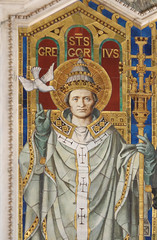In Daniel 9:2 appears the oldest name with which the Scriptures
are known: ספרים
(books). This term refers to the Jewish scriptures that were
inherited as a Greek edition by Christianity at the beginning of the early
Church as the authentic Word of God (Jn 10:35; Acts 9:2; 16: 17; 18:25-26;
19:8-9; Rom 15:4; 1 Cor 10:11). To these sacred writings, the early Christians
added some other Scriptures to that expressed their faith in the Messiah, Jesus Christ.
Therefore the Christian corpus of sacred scriptures became a composition of two
collections of books: those which were considered already as authoritative scriptures by many before the death of
Jesus (2 Mac 8:23; Rom 1:2; 2 Tim 3:15-16) and those which were written after his
glorification (Acts 1:1-2; 2 Pet 3:15-16).
Christianity understood that between these two sets of written
works there is an intrinsic relationship (cf. Lk 24:13-27), as Augustine of
Hippo perceived: “The New Testament is hidden in the Old and the Old is
manifest in the New.” (Quaestiones in
Heptateuchum, 2, 73: PL 34, 623). This statement
represents what the Church believed since her inception: that the Christian
bible is composed of two “Covenants” (testaments). With this assertion as the background and as the principal hermeneutical key, biblical scholars,
theologians and pastors have acknowledged the authority of the Hebrew bible
along the centuries. However, in different historical moments,
circumstances have tried to change the understanding of this relationship,
either rejecting completely the Old Testament, like Marcion (c.140 CE) or
focusing in the literal reading of the Hebrew Scriptures as some fundamentalist
Christian denominations still defend.
| Pope St Gregory the Great (Photo credit: Lawrence OP) |
For Christians the relationship between the Old and the New Testament
is interdependent and reciprocal. As the
New Testament claims to be read in the light of the Old, a re-reading of the
Jewish scriptures in the light of Christ and the salvific event becomes necessary
and essential (Lk 24:25). As the origins
of the Christian faith are found in the Old Testament, Christianity is always
being shaped by this heritage (Lk 24:44-48). However, this relationship is
maintained by aspects of continuity, discontinuity and fulfillment: “What the
Old Testament promised, the New Testament made visible; what the former announces
in a hidden way, the latter openly proclaims as present. Therefore the Old Testament
is a prophecy of the New Testament; and the best commentary on the Old Testament
is the New Testament.” (Gregory the Great, Homiliae in Ezechielem, I,
VI, 15; PL 76, 836B)
These reflections should highlight the key importance and essential value of the Old
Testament for Christians, while at the same time bringing out the newness of its Christological interpretation. (VD, 41)




0 comments:
Post a Comment